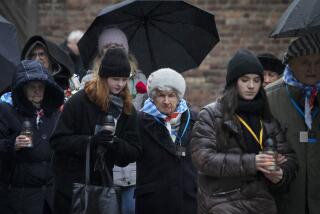Moment of Friday: A drone video of Auschwitz, field of nightmares
This week marked the 70th anniversary of the liberation of the Auschwitz-Birkenau death camp. To commemorate the occasion, the BBC produced a six-minute video (embedded above) using a drone that flies over and around the infamous Nazi site in Poland to capture images of fields marked with the remains of wooden huts at Birkenau, blocks of still-standing Auschwitz I barracks and railway tracks leading to the camp’s entrance. It’s a stirring wordless tribute to the mass murder that took place there.
Having never been to Auschwitz, the video also presented me with a stark reminder of the camp’s citadel size. (It was roughly 50 acres.) And there was its nightmarishly efficient architecture of death: the gate with the grotesque welcoming sign “Work Shall Set You Free,” the endless rows of barracks, the so-called “showers” that bathed prisoners in lethal gas, and the crematoriums that were used to dispose of the innumerable bodies.
Building a system that can take life on such a large scale — anywhere from 1.1 to 1.5 million people were killed at Auschwitz alone — required large-scale urban planning and specially built architecture.
It wasn’t easy, as chronicled in the 2005 BBC documentary “Auschwitz: Inside the Nazi State” (now streaming on Netflix). Likewise, PBS has a report that documents the different methods of murder the Nazis attempted before settling on their poison gas system.
As we think about the ways in which humans can kill, the BBC’s moving drone video is a reminder about how design can aid and abet that.
Never again, indeed.
Find me on Twitter @cmonstah.
More to Read
The biggest entertainment stories
Get our big stories about Hollywood, film, television, music, arts, culture and more right in your inbox as soon as they publish.
You may occasionally receive promotional content from the Los Angeles Times.







